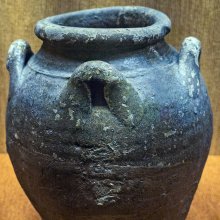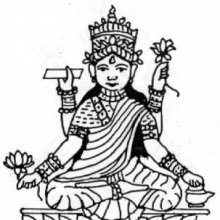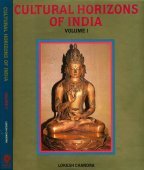Jar: 4 definitions
Introduction:
Jar means something in Hinduism, Sanskrit, biology. If you want to know the exact meaning, history, etymology or English translation of this term then check out the descriptions on this page. Add your comment or reference to a book if you want to contribute to this summary article.
Images (photo gallery)
(+10 more images available)
Biology (plants and animals)
Source: Google Books: CRC World Dictionary (Regional names)1) Jar in India is the name of a plant defined with Salvadora persica in various botanical sources. This page contains potential references in Ayurveda, modern medicine, and other folk traditions or local practices It has the synonym Salvadora paniculata Zucc. ex Steud. (among others).
2) Jar in Pakistan is also identified with Salvadora oleoides.
Example references for further research on medicinal uses or toxicity (see latin names for full list):
· Species Plantarum (1753)
· J. Proc. Linn. Soc., Bot. (1860)
· Nomenclator Botanicus (1840)
· Voyage dans l’Inde. (1841)
· Cytologia (1988)
· Jacquemont, Victor (1801–1832), (1801)
If you are looking for specific details regarding Jar, for example extract dosage, chemical composition, health benefits, pregnancy safety, side effects, diet and recipes, have a look at these references.

This sections includes definitions from the five kingdoms of living things: Animals, Plants, Fungi, Protists and Monera. It will include both the official binomial nomenclature (scientific names usually in Latin) as well as regional spellings and variants.
Languages of India and abroad
Sanskrit dictionary
Source: Cologne Digital Sanskrit Dictionaries: Cappeller Sanskrit-English DictionaryJar (जर्).—jarate (cf. car) awake, stir, move, approach ([accusative]). [Causative] jarayati, te awaken, set in motion.
[Sanskrit to German]
Sanskrit, also spelled संस्कृतम् (saṃskṛtam), is an ancient language of India commonly seen as the grandmother of the Indo-European language family (even English!). Closely allied with Prakrit and Pali, Sanskrit is more exhaustive in both grammar and terms and has the most extensive collection of literature in the world, greatly surpassing its sister-languages Greek and Latin.
See also (Relevant definitions)
Starts with (+499): Jar taramniya, Jar-khair, Jara, Jara bindi, Jara Sutta, Jara Utanem, Jara Vagga, Jara-mara, Jaraasi, Jaraba, Jarababa, Jarabajara, Jarabakshapatashahishrimahamudasuratranacarita, Jarabanda, Jarabanem, Jarabhara, Jarabhaya, Jarabhibhuta, Jarabhiru, Jarabhita.
Ends with (+41): Adjardjar, Ajar, Anatippancar, Baayejar, Bajar, Ban gajar, Banjar, Barakulanjar, Bayejar, Dhup jar, Didjar, Ejar, Flour jar, Gairhajar, Gajar, Gunjar, Hajar, Hamilatpancar, Indirajar, Isharmul-ki-jar.
Full-text (+677): Alinjara, Kalasha, Karkari, Kumbha, Ghritakumbha, Udakumbha, Vrinta, Alanjara, Vishakumbha, Kalashi, Bhadrakumbha, Manika, Purnakumbha, Barani, Ratnakumbha, Vardhani, Kanakaluka, Cati, Kalasheya, Ghataraja.
Relevant text
Search found 203 books and stories containing Jar; (plurals include: Jars). You can also click to the full overview containing English textual excerpts. Below are direct links for the most relevant articles:
Vakyapadiya of Bhartrihari (by K. A. Subramania Iyer)
Verse 2.123 < [Book 2 - Vākya-kāṇḍa]
Verse 3.6.15 < [Book 3 - Pada-kāṇḍa (6): Dik-samuddeśa (On Position)]
Verse 3.1.105 < [Book 3 - Pada-kāṇḍa (1): Jāti-samuddeśa (On the Universal)]
Brahma Sutras (Ramanuja) (by George Thibaut)
Sutra 2.2.23 < [Second Adyaya, Second Pada]
Sutra 2.1.17 < [Second Adyaya, First Pada]
Sutra 2.2.19 < [Second Adyaya, Second Pada]
The Tattvasangraha [with commentary] (by Ganganatha Jha)
Verse 2131-2132 < [Chapter 24a - The case for the reliability of the Veda (the Revealed Word)]
Verse 807 < [Chapter 13 - Examination of Sāmānya (the ‘universal’)]
Verse 2141 < [Chapter 24a - The case for the reliability of the Veda (the Revealed Word)]
Rig Veda (translation and commentary) (by H. H. Wilson)
Yoga-sutras (with Bhoja’s Rajamartanda) (by Rajendralala Mitra)
Sūtra 3.13 < [Third Chapter (Vibhuti Pada)]
Sūtra 4.13 < [Fourth Chapter (Samadhi Pada)]
Sūtra 4.18 < [Fourth Chapter (Samadhi Pada)]
Brahma Sutras (Nimbarka commentary) (by Roma Bose)
Brahma-Sūtra 3.2.32 (correct conclusion, 32-37) < [Adhikaraṇa 7 - Sūtras 31-37]
Brahma-Sūtra 3.2.20 (correct conclusion, 20-21) < [Adhikaraṇa 5 - Sūtras 11-21]
Brahma-Sūtra 2.3.45 < [Adhikaraṇa 12 - Sūtras 42-52]
Related products









